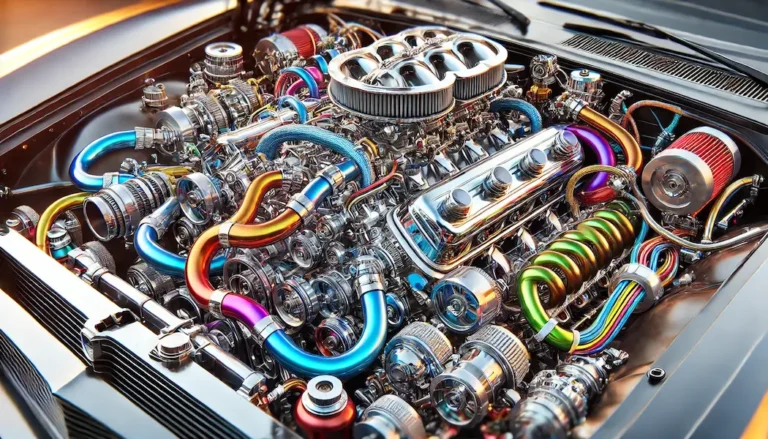Hyundai Check Engine Light: Common Issues

Key Takeaway
The check engine light in your Hyundai isn’t just a random warning; it’s like your car giving you a little nudge when something needs your attention. I’ve been there—the light flickers on, and you immediately feel a mix of anxiety and confusion. But don’t worry! Understanding what can trigger this alert is crucial for keeping your vehicle running smoothly and saving yourself from potential headaches. Let’s dive into some common issues that could cause that pesky light to shine.
Introduction
If you’re a Hyundai owner, you probably cherish the reliability and performance of your vehicle. But when that check engine light suddenly lights up, it can feel like a mini heart attack. Trust me; I’ve been in your shoes, staring at that dashboard wondering what could be wrong. The good news? Often, it’s a relatively simple fix. This guide is designed to help you navigate the most common reasons your check engine light might come on, what to look for, and how to handle it.
What Does the Check Engine Light Mean?
So, what’s the deal with the check engine light? That little engine icon on your dashboard is part of your car’s onboard diagnostics system. When your vehicle’s computer detects an issue—whether it’s with the engine, emissions system, or something else—it triggers this warning light. It can indicate everything from minor annoyances to significant problems that need your immediate attention.
Types of Check Engine Light Alerts
- Steady Check Engine Light: This usually means something’s off, but it’s not a crisis. You might want to schedule a service soon, but you can breathe a little easier.
- Flashing Check Engine Light: Uh-oh, this one’s serious! It usually points to engine misfires or other urgent problems. If this happens, pull over safely and stop driving to avoid further damage.
Importance of Diagnosing Issues Promptly
When that check engine light pops up, I can’t stress enough how important it is to address the underlying problem right away. Ignoring it can lead to decreased fuel efficiency, increased emissions, and even potential damage to other engine components. I’ve learned the hard way that regular diagnostics can catch issues before they escalate into costly repairs.
Common Reasons for the Check Engine Light
Understanding the typical causes of the check engine light can help you spot potential problems early. Here are some of the most common issues that could trigger that warning light in your Hyundai.
1. Loose or Damaged Gas Cap
Issue Overview: One of the simplest and most common reasons for the check engine light to illuminate is a loose or damaged gas cap. Believe me, I’ve had moments where I panicked only to find it was just my gas cap!
What to Do: Make it a habit to ensure your gas cap is tightly secured. If it looks damaged, a quick replacement can save you from fuel evaporation issues.
Symptoms:
- Decreased fuel efficiency
- Fuel smell around the vehicle
2. Faulty Oxygen Sensors
Issue Overview: Oxygen sensors play a crucial role in monitoring the level of oxygen in your exhaust and regulating fuel efficiency. When these sensors fail, you might notice a drop in fuel economy.
What to Do: If the check engine light is glowing, and you’re feeling your wallet getting lighter at the pump, it might be time to check those oxygen sensors. They’re usually an easy fix.
Symptoms:
- Decreased fuel efficiency
- Rough idling
- Increased emissions
3. Malfunctioning Catalytic Converter
Issue Overview: The catalytic converter is vital for reducing harmful emissions. If it’s not working properly, it can lead to significant drops in fuel efficiency and engine performance.
What to Do: If you suspect your catalytic converter is acting up, don’t wait. I once ignored this issue, and it led to a costly repair. Consult a professional to diagnose the problem early.
Symptoms:
- Decreased fuel efficiency
- Poor acceleration
- Unusual noises from the exhaust
4. Spark Plug Issues
Issue Overview: Worn or fouled spark plugs can wreak havoc on your engine, leading to misfires and poor performance. If you notice a rough idle, it could be time for a spark plug check.
What to Do: Regularly inspecting and replacing spark plugs can keep your engine running smoothly. It’s a small step that makes a big difference—I’ve found that fresh spark plugs can rejuvenate a tired engine.
Symptoms:
- Rough idling
- Poor acceleration
- Engine misfires
5. Faulty Mass Airflow Sensor
Issue Overview: The mass airflow (MAF) sensor measures the air entering the engine to ensure the right fuel-to-air mixture. A faulty MAF can cause your engine to run inefficiently.
What to Do: If your check engine light is on and your car is acting sluggish, have the MAF sensor checked. I’ve learned that cleaning or replacing this sensor can make a noticeable difference.
Symptoms:
- Stalling
- Poor acceleration
- Rough idle
6. Engine Issues
Issue Overview: More serious engine problems can also trigger the check engine light. Issues like low oil pressure, engine overheating, or internal failures may require immediate attention.
What to Do: If you hear weird noises or feel something’s off, it’s definitely time to chat with a mechanic. I once ignored engine noises, thinking they’d resolve themselves, and it turned into a costly mistake.
Symptoms:
- Unusual noises (knocking or pinging)
- Engine overheating
- Low oil pressure
7. Transmission Issues
Issue Overview: Transmission problems can also lead to the check engine light illuminating. Low transmission fluid or failure can cause serious issues.
What to Do: If you’re experiencing shifting problems or if the light comes on, have your transmission fluid levels checked. Trust me; addressing this early can save you from a lot of trouble.
Symptoms:
- Slipping gears
- Delayed or rough shifting
- Unusual noises from the transmission
Diagnosing the Check Engine Light
When that light comes on, diagnosing the issue is essential. Here’s how I usually approach it:
1. Read the Codes
Using an OBD-II scanner, you can pull diagnostic trouble codes (DTCs) from your vehicle. Many auto parts stores offer free code-reading services. I’ve found this step super helpful for narrowing down potential issues.
2. Interpret the Codes
Once you have the codes, look them up online or check your vehicle’s service manual. This can give you a clearer picture of what might be wrong and whether it’s something you can tackle yourself.
3. Visual Inspection
After retrieving the codes, do a visual inspection of related components. Look for loose wires, damaged connectors, or other signs of wear. Sometimes, the solution is right in front of you.
4. Consult a Professional
If diagnosing the issue feels overwhelming, or if the problem persists after your checks, it’s best to consult a professional mechanic. Their expertise can save you time and hassle.
Preventative Maintenance Tips
To avoid future check engine light incidents, consider these tips:
1. Regularly Check Your Gas Cap
Make it a habit to check your gas cap for tightness and damage every time you fill up. It’s a quick step that can save you from minor issues.
2. Change Spark Plugs and Wires
Follow your manufacturer’s recommendations for changing spark plugs and wires. I can’t tell you how much smoother my car ran after I replaced mine.
3. Monitor Fluid Levels
Regularly check all fluid levels, including oil, coolant, and transmission fluid. Keeping these at optimal levels can prevent many engine-related issues.
4. Use Quality Fuel
Using high-quality fuel can help prevent carbon buildup in your engine and fuel system, leading to better performance.
5. Schedule Regular Maintenance
Following your vehicle’s maintenance schedule is crucial. Regular check-ups can catch issues before they turn into bigger problems, and I’ve found it gives me peace of mind.
What to Do if the Check Engine Light Is On
If your check engine light comes on, here’s a step-by-step approach:
- Check for Obvious Issues: Start with the gas cap. If it’s loose, tighten it and see if the light goes off after a few drives.
- Read the Codes: Use an OBD-II scanner to read the codes. This will guide you to potential issues.
- Perform a Visual Inspection: Look for any visible signs of damage or loose connections related to the issue indicated by the codes.
- Consider Resetting the Light: If you’ve addressed a minor issue, you may reset the check engine light by disconnecting the battery for a few minutes or using a scanner. If the light comes back on, it indicates that the issue still exists.
- Visit a Mechanic: If you cannot resolve the issue or if you experience significant changes in performance, seek professional help.
Conclusion
The check engine light in your Hyundai serves as an important indicator of your vehicle’s health. Understanding common causes can help you take proactive steps to maintain your car and avoid costly repairs. I hope this guide empowers you to handle the check engine light with confidence.
If you’re ever unsure about an alert, don’t hesitate to consult a trusted mechanic. Staying informed and proactive can lead to a more enjoyable driving experience and greater peace of mind. Remember, taking care of your vehicle today means fewer headaches tomorrow!
FAQs
1. What should I do if my check engine light comes on?
Start by checking your gas cap. If it’s secure and the light remains on, use an OBD-II scanner to read the codes. A visual inspection of related components can also help identify issues. If you’re unsure, consult a mechanic for a professional diagnosis.
2. Can I drive with the check engine light on?
If the light is steady, you may be okay to drive for a short time, but it’s best to get it checked soon. If the light is flashing, you should pull over immediately to avoid causing further damage to your engine.
3. How much does it cost to fix check engine light issues?
The cost varies widely depending on the problem. Simple fixes like replacing a gas cap or spark plugs can be relatively inexpensive, while issues like a faulty catalytic converter may cost significantly more. Getting a diagnostic can help you understand potential costs.
4. Will my car fail an emissions test if the check engine light is on?
Yes, most emissions tests will fail if the check engine light is illuminated. It’s best to resolve the issue before taking your vehicle in for testing.
5. How can I prevent my check engine light from coming on?
Regular maintenance is key. Keep up with oil changes, monitor fluid levels, check your gas cap, and replace spark plugs as needed. Using quality fuel and adhering to your vehicle’s service schedule can also help prevent issues.
Thanks for checking out this article on EngineEcho.com! Hope you found this article: "Hyundai Check Engine Light: Common Issues" helpful! If you liked it and want to dive into more car engine topics, head over to our homepage. There's always something new to discover in the world of engines. Enjoy your reading journey!
Check out our previous article: Where to Buy VR38 Engines






